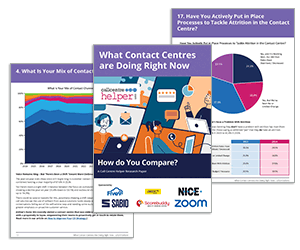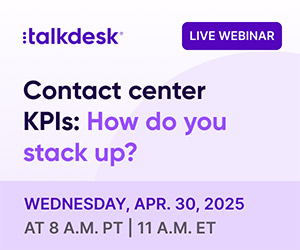Achieving a high First Contact Resolution (FCR) rate is essential for delivering excellent customer service. Improving FCR not only enhances customer satisfaction but also reduces operational costs and increases agent efficiency.
In this article, we’ll explore 5 practical steps to improve first contact resolution in your contact centre.
What Is First Contact Resolution (FCR)?
FCR stands for First Contact Resolution and refers to the ability of a company’s customer support team to resolve a customer’s issue or enquiry during their first interaction, without the need for follow-up or escalation.
High FCR rates indicate that agents are well equipped to handle issues promptly and accurately, improving customer satisfaction, customer churn and sales opportunities.
How to Measure First Contact Resolution
Measuring FCR accurately can be challenging. While some contact centres rely on quality assurance (QA) reviews or repeat contact analysis, these methods have limitations.
| Method | Pros | Cons |
|---|---|---|
| QA Reviews | QA analysts can assess whether agents followed the correct process to resolve issues. | This method reflects the organization’s view, not the customer’s. QA teams may also focus on shorter interactions to meet review quotas, which can distort FCR results. |
| Repeat Contact Analysis | Tracks all customer contacts, e.g. identifying if 30% of calls within five days came from repeat contacts. | This method can misrepresent FCR, as repeat contacts may be about different issues. Channel-switching (e.g. moving from chat to phone) can also complicate tracking. |
The most customer-focused way to measure FCR is by asking customers directly. After a service interaction, send a VOC survey via email or SMS with two key questions:
- Was your issue resolved during your most recent interaction? (Yes, No, Not sure)
- Including your most recent interaction, how many contacts did it take to resolve your issue? (1, 2, 3 or more)
For an interaction to count as resolved at first contact, the customer must answer ‘Yes’ and ‘1’. Combining VOC data with insights from QA reviews and repeat contact analysis provides the most accurate and balanced view of FCR.
5 Steps to Improve First Contact Resolution
1. Establish Your FCR Baseline
Start by measuring your current First Contact Resolution (FCR) rate to understand where you stand. Use data from QA reviews, repeat contact analysis, and Voice of the Customer (VOC) surveys to establish a clear benchmark.
This baseline will help you:
- Identify common issues that require multiple contacts.
- Highlight training gaps or process inefficiencies.
- Track improvements over time as you implement new strategies.
2. Pinpoint the Root Causes of Repeat Contacts
Analyse data from customer interactions to uncover the main reasons why issues aren’t resolved on the first contact.
Common causes may include:
- Knowledge gaps – Agents lacking the right information.
- Process issues – Complex procedures that delay resolution.
- System limitations – Outdated or inefficient tools.
- Product or service issues – Faults or unclear instructions that lead to repeat contacts.
By identifying these root causes, you can take targeted actions such as improving training, updating processes, or enhancing system capabilities to improve FCR.
3. Set Clear Goals and Prioritize Actions
Once you’ve identified the root causes, prioritize solutions based on their impact and feasibility. Focus on quick wins that can deliver immediate improvements, while also planning for longer-term changes.
Define a clear FCR goal that aligns with your organization’s customer service objectives. For example, aim to improve your FCR rate by a specific percentage within a set timeframe.
Setting measurable targets and prioritizing key actions ensures your team stays focused and can track progress effectively.
4. Maximize Your Impact
To achieve meaningful improvements in FCR, ensure that changes are implemented across all areas of your contact centre. This includes:
- Ongoing training to keep agents up to date with new information and skills.
- Optimizing technology, like CRM systems or knowledge bases, to make it easier for agents to resolve issues in one interaction.
- Streamlining processes to eliminate unnecessary steps that slow down resolution.
By creating a holistic approach, you ensure that improvements in FCR are sustainable and impactful across your entire operation.
5. Continuously Track FCR Performance
Once you have implemented all improvements, it is important to continuously monitor your First Contact Resolution rate regularly to ensure that improvements are sustained over time.
Keep using real-time data, VOC surveys, and customer feedback to gauge performance and identify any new potential challenges.
Establish a system for ongoing tracking, such as daily or weekly reports, so you can quickly address any declines or issues. By continuously monitoring FCR, you can adapt and optimize strategies as needed to maintain high levels of customer satisfaction.
This article is a revised version of Improve First Contact Resolution (FCR), originally published by NICE.
For more insights on first contact resolution and improving customer service, read these articles next:
- 20 First Call Resolution Tips (FCR)
- How to Calculate First Contact Resolution (FCR) – With Formula
- What Is First Contact Resolution? – With Formula and Expert Best Practices
Author: Hannah Swankie
Reviewed by: Jo Robinson
Published On: 9th Apr 2025
Read more about - Expert Insights, First Contact Resolution (FCR), Key Performance Indicators (KPIs), NICE, NICE Satmetrix






































